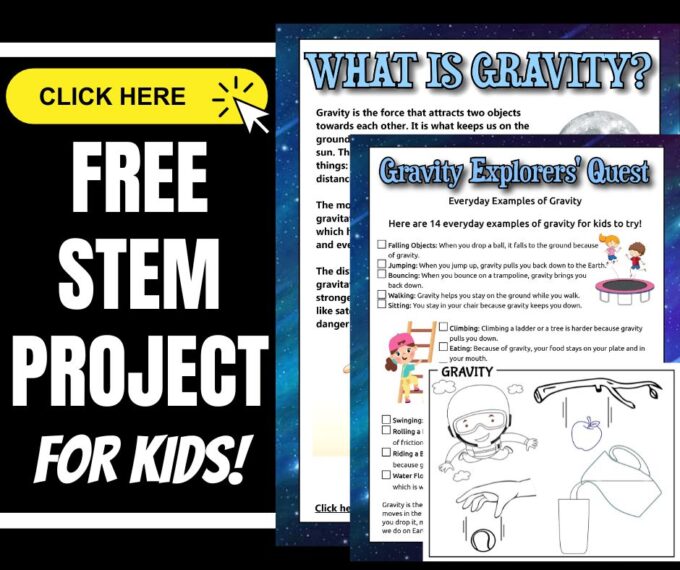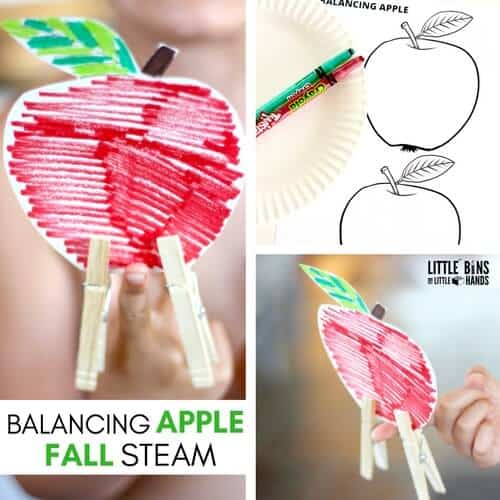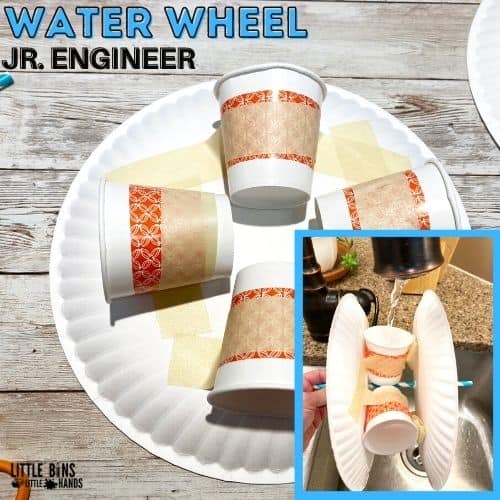Why do things fall to the ground when you let go of them? It’s all to do with gravity! Learn about what gravity is with a simple definition and everyday examples of gravity. Explore simple physics with easy, hands-on experiments kids will love. From falling objects, balancing apples, and even an egg drop challenge, enjoy these fun gravity science projects for kids!
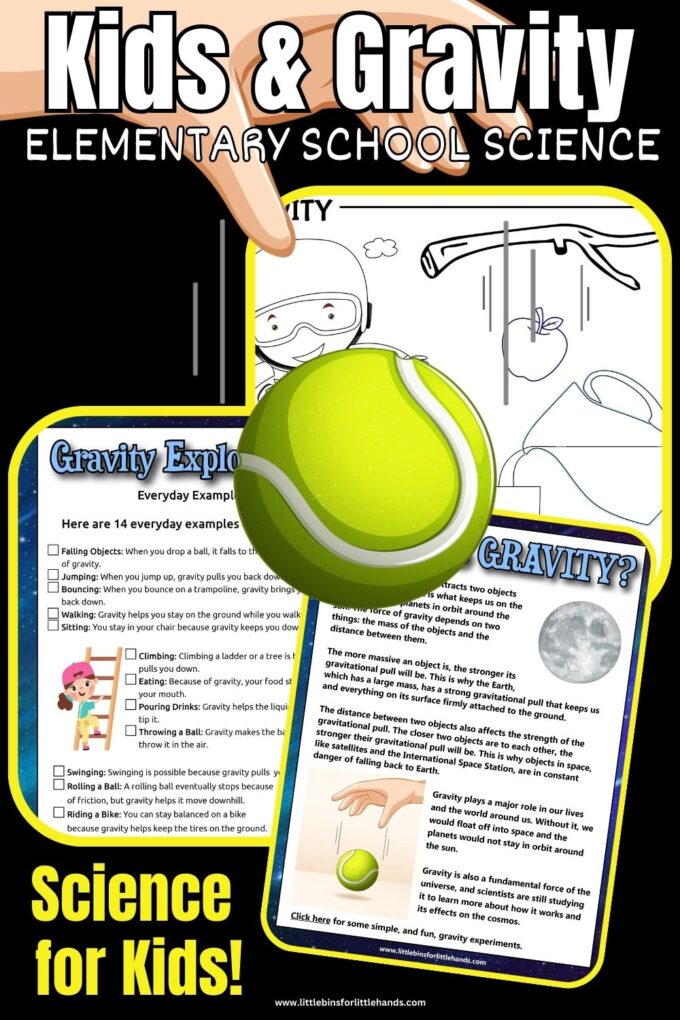
What Is Gravity?
Earth’s gravity is the force that keeps everything on the planet’s surface and makes things fall to the ground. Good thing!
Imagine you are standing on the ground, and there’s an invisible force pulling you down toward the Earth. That force is called gravity. It’s like a giant magnet that attracts everything with mass toward the center of the Earth.
The Earth is super big and has a lot of mass, which means it has a strong pull. That’s why we don’t float away into space like astronauts do when they’re far from Earth. Instead, gravity keeps us firmly planted on the ground.
Have you ever watched a NASA video of an astronaut floating around inside his/her ship?
The Moon also has gravity, but its pull is not as strong because it’s much smaller than Earth. That’s why astronauts can jump higher on the Moon than on Earth! Even if you can jump really high, you’ll still come back down!
Now, the Earth’s gravity doesn’t just work on you; it also works on everything around you, living and nonliving! It pulls down the trees, the buildings, and even the air you breathe.
That’s why things always fall when you drop them. The Earth’s gravity is pulling them like the glass of milk that my son knocked off the table this morning! When you throw a ball up in the air, it comes back down because of gravity!
Gravity is a fantastic force that keeps our feet on the ground, helps things stay where they are, and makes the world work together. Without gravity, everything would be floating around in space. So, we can thank Earth’s gravity for making our planet such a fantastic place to live!
Have younger kiddos? Check out these fun gravity activities for preschool and kindergarten.
Gravity Defined
For older kids, a more in-depth understanding of how gravity affects objects involves exploring the concepts of gravitational force, mass, distance, and the universal law of gravitation proposed by Isaac Newton. You can find more science terms explained here.
Gravitational Force
Gravity is the force of attraction between all objects with mass. The greater the mass of an object, the stronger its gravitational pull. This force keeps planets in orbit around the Sun and objects on Earth grounded.
Mass
Mass is the amount of matter in an object. The more massive a thing is, the more gravitational force it exerts and experiences. The relationship between mass and gravitational force is directly proportional: if you double the mass of an object, its gravitational force doubles as well.
Distance
The distance between two objects also affects the gravitational force between them. The greater the distance, the weaker the gravitational force. This relationship follows the inverse square law, which means that if you double the distance between two objects, the gravitational force becomes one-fourth as strong.
Universal Law of Gravitation
Isaac Newton formulated a law that describes how gravitational force works universally. It states that every object with mass attracts every other object with mass with a force that is directly proportional to the product of their masses and inversely proportional to the square of the distance between them. Read about Isaac Newton’s famous experiment below.
Free Fall
When an object falls under the influence of gravity alone, it is said to be in free fall. Without air resistance, all objects fall at the same rate regardless of their masses. This is known as the principle of equivalence, demonstrated famously by Galileo dropping objects from the Leaning Tower of Pisa.
Weight
Weight is the force of gravity acting on an object’s mass. It is different from mass, as it depends on both mass and acceleration due to gravity. Weight is often measured in newtons (N) or pounds (lb) and is calculated using the equation:
Weight = mass x acceleration due to gravity
Understanding these concepts helps kids comprehend gravity’s role in the universe and how it influences the behavior of objects of different masses and distances.
The Most Famous Gravity Experiment
Sir Isaac Newton is famous for many contributions to physics, and his experiments with gravity are among his most renowned works. One of the key experiments associated with Newton’s study of gravity is often called the “Newton’s Falling Apple,” which is a story rather than a controlled experiment.
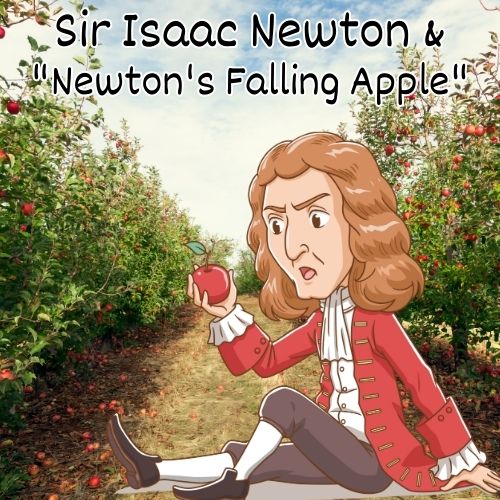
According to the legend, Newton was sitting under an apple tree in his garden when he saw an apple fall to the ground. This event got him thinking about the force that caused the apple to fall. Newton realized that the same force, gravity, was responsible for the apple’s fall and the motion of bodies in space like the Moon and planets.
While this story is well-known, it’s important to note that it wasn’t a formal experiment. However, Newton conducted a series of experiments and observations to develop his laws of motion and the law of universal gravitation. These experiments and observations included:
- Prism Experiments: Newton’s experiments with prisms and light led to his groundbreaking work on optics, which is separate from gravity but an important part of his overall scientific contributions. See Newton’s color wheel spinner.
- Mathematical Calculations: Newton used mathematics to formulate his laws of motion and universal gravitation. He developed the mathematics of calculus to help describe and predict the behavior of objects under the influence of gravity.
- Kepler’s Laws: Newton built upon Johannes Kepler’s laws of planetary motion to develop his laws of universal gravitation. Kepler’s work was based on extensive astronomical observations.
So, while there isn’t a specific experiment directly related to the falling apple, Newton’s contributions to our understanding of gravity are based on a combination of observations, mathematical calculations, and experiments.
Have fun with physics! Check out our complete list of easy physics experiments.
Everyday Examples of Gravity
Here are 15 everyday examples of gravity that are easy for kids to understand:
- Falling Objects: When you drop a ball, it falls to the ground because of gravity.
- Jumping: When you jump up, gravity pulls you back down to the Earth.
- Walking: Gravity helps you stay on the ground while you walk.
- Sitting: You stay in your chair because gravity keeps you down.
- Climbing: Climbing a ladder or a tree is harder because gravity pulls you down.
- Bouncing: When you bounce on a trampoline, gravity brings you back down.
- Swinging: Swinging on a swing set is possible because gravity pulls you back towards the Earth.
- Driving: Your car stays on the road because of gravity.
- Eating: Because of gravity, your food stays on your plate and in your mouth.
- Pouring Drinks: Gravity helps the liquid flow from a cup when you tip it.
- Throwing a Ball: Gravity makes the ball come back down after you throw it in the air.
- Rolling a Ball: A rolling ball eventually stops because of friction, but gravity helps it move downhill.
- Riding a Bike: You can stay balanced on a bike because gravity helps keep the tires on the ground.
- Water Flow: Water flows downhill because of gravity, which is why rivers and streams exist.
- Kite Flying: Gravity keeps the kite from flying too high, and the tension in the string is balanced by gravity pulling it downward.
Can you think of any more examples of gravity?
Free Gravity Information and Activity Printable
Get up and test gravity for yourself with a free gravity activity pack! Share this information guide, quick activity, and gravity coloring sheet with your kids!
Tips For Teaching Kids About Gravity
1. Keep It Hands-on
Kids learn best through hands-on experiences, especially when it comes to abstract concepts like gravity. These gravity experiments below allow them to directly interact with materials and observe concrete examples of gravity in action, making scientific concepts more tangible and understandable.
2. Predict-Observation-Explanation Cycle
Use the scientific method‘s basic cycle of predicting outcomes, making observations, and explaining results. This helps kids develop critical thinking skills, and an understanding of how science works. Learn more about the scientific method for kids.
3. Variety of Learning Styles
These activities cater to various learning styles. Some children learn best by seeing, others by doing, and some by discussing. These experiments encompass all these styles, ensuring that different types of learners can benefit.
4. Use Real Life Applications
Many of these experiments represent everyday situations, such as dropping objects or rolling things down ramps. This connection to real life helps children see the relevance of science in their world and apply concepts of gravity when they are not in the classroom.
You Might Also Like Real World STEM Project Template
5. Encourage Curiosity
Encourage curiosity and exploration in kids by giving them opportunities to ask questions and seek answers. This is how they develop a natural sense of wonder about the world around them, fostering a lifelong interest in learning.
Grab your FREE printable science worksheets!
12 Gravity Experiments To Try
Here are 12 gravity science experiments that are great for elementary school kids. Learn about gravity and its effects in a fun and hands-on way.
You may also want to explore: Air Resistance Projects
Dropping Objects
Gather various objects of different weights and sizes (e.g., a feather, a paperclip, a small ball). Have kids predict which object will hit the ground first when dropped simultaneously and then test their predictions.
Paper Airplane Challenge
Have kids create paper airplanes of different sizes and shapes. Let them fly the planes and observe how gravity affects their flight paths differently based on their designs. See how to make a paper airplane launcher.
Falling Rates
Use a ruler or a measuring tape to drop different objects from the same height and measure the time it takes for them to reach the ground. Compare the falling rates of various objects.
Balloon Rocket
Attach a string to a balloon and tape the other end to a straw. Inflate the balloon and then release it. Observe how the air escaping from the balloon propels the straw in the opposite direction due to Newton’s Third Law of Motion.
Coin and Card Drop
Place a playing card on the edge of a table and let half of it hang over the edge. Hold a coin over the card’s hanging part and let it go. The card will fall due to gravity, but the coin’s rapid descent might surprise the kids as they learn about mass and air resistance.
Water Upward
Fill a glass with water and place a piece of cardboard on top. Hold the cardboard and glass firmly together, then quickly turn the glass upside down. The water will stay inside the glass due to air pressure, demonstrating the balance between gravity and air pressure.
Rolling Race
Set up a ramp using books or a board. Have kids release different objects (marbles, toy cars) from the top of the ramp and see which one reaches the bottom first. Discuss how gravity affects the speed of rolling objects. See how to set it up with toy cars, pumpkins, apples and plastic Easter eggs.
Gravity-Powered Pendulum Painting
Attach a small container with paint to the bottom of a pendulum (a string with a weight at the end). Set the pendulum in motion and observe how it creates unique patterns on a piece of paper beneath it.
Crumpled Paper Drop
Crumple two pieces of paper into balls, one larger and one smaller. Drop them both at the same time and discuss how their sizes and air resistance affect their falling speed.
Balancing Act
Have kids experiment with balancing different objects on their fingertips. Discuss how the weight and shape of objects affect their balance due to the force of gravity. Have fun balancing animal puppets, mobile of paper shapes, pumpkins, and paper apples.
Egg Drop Challenge
Provide kids with materials like straws, rubber bands, tape, and newspapers. Challenge them to design a structure that will protect a raw egg when dropped from a certain height, demonstrating how objects experience less impact force when they have more time to slow down (larger parachutes or cushioning). See our egg drop ideas for younger and older students.
Water Wheel
Build a simple water wheel using a plastic container, a stick, and a paper cup. Place the water wheel under a steady stream of water and observe how gravity causes the wheel to turn. See how to build a simple water wheel here.
Helpful Science Resources To Get You Started
Here are a few resources that will help you introduce science more effectively to your kiddos or students and feel confident yourself when presenting materials. You’ll find helpful free printables throughout.
- Best Science Practices (as it relates to the scientific method)
- Science Vocabulary
- 8 Science Books for Kids
- All About Scientists
- Science Supplies List
- Science Tools for Kids
- Join us in the Club
Printable Science Projects For Kids
If you’re looking to grab all of our printable science projects in one convenient place plus exclusive worksheets and bonuses like a STEAM Project pack, our Science Project Pack is what you need! Over 300+ Pages!
- 90+ classic science activities with journal pages, supply lists, set up and process, and science information. NEW! Activity-specific observation pages!
- Best science practices posters and our original science method process folders for extra alternatives!
- Be a Collector activities pack introduces kids to the world of making collections through the eyes of a scientist. What will they collect first?
- Know the Words Science vocabulary pack includes flashcards, crosswords, and word searches that illuminate keywords in the experiments!
- My science journal writing prompts explore what it means to be a scientist!!
- Bonus STEAM Project Pack: Art meets science with doable projects!
- Bonus Quick Grab Packs for Biology, Earth Science, Chemistry, and Physics.


